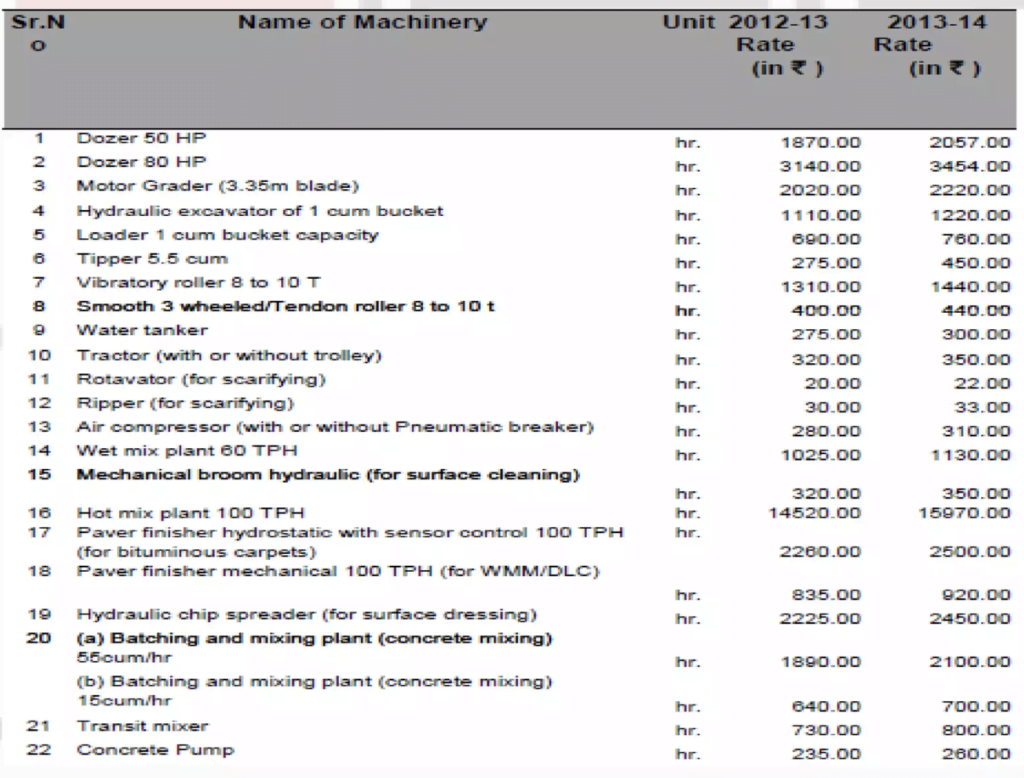A Schedule of Rates (SOR) is a crucial document that outlines the charges applicable to different tasks or work items undertaken by a contractor. It plays a foundational role in estimating project costs, encompassing not just direct expenses but also additional costs related to transporting materials from authorized sources to the project site. It’s vital for governmental and public entities, including trusts and NGOs, to ensure that contract award procedures are both competitive and transparent by inviting bids from multiple parties.
Before initiating any construction project, government agencies must meticulously calculate expected costs to facilitate effective financial planning, enabling better budget management throughout the project’s duration.
The construction of architectural elements involves intricate processes, with costs influenced by various factors like material expenses, labor, and necessary scaffolding. For example, determining the cost of brick masonry per cubic meter for wall construction requires considering variables such as sand, mortar, labor, and curing.
Through thorough rate analysis, departments establish rates for different construction items, considering contributions from materials, labor, equipment, scaffolding, and overhead costs. This meticulous assessment ensures accurate projection of project costs and enables efficient budget planning.
Moreover, the Schedule of Rates serves as a basis for contract pricing and allows for comparison of prices among different contractors. It provides a standardized framework for evaluating project costs, streamlining procurement processes, and enhancing overall project management effectiveness.

Significance
The Schedule of Rates (SOR) holds paramount importance in the realm of construction projects and tendering processes. This document meticulously lists the rates applicable to various tasks or work items, serving as a definitive guide for pricing contracts and tenders. Within the SOR, each item is accompanied by a detailed description of the work, the unit of measurement, and the corresponding rate per unit, ensuring transparency and clarity in financial dealings. By establishing a uniform pricing structure for similar work across diverse projects, the SOR fosters consistency and fairness in the contracting and tendering arena.
Its role in disseminating crucial pricing information to all stakeholders involved cannot be overstated, as it mitigates the potential for disagreements and misunderstandings. Ultimately, the SOR serves as a cornerstone for promoting efficiency, transparency, and accountability in the construction industry, facilitating smoother project execution and fostering trust among parties engaged in the tendering and contracting process.
Required Documents
The tender documents will present a significant package akin to a bill of quantities, incorporating various options and potential discounts based on quantity. The document may contain sections labeled with headings like:
- General conditions
- Measurement methods
- Ethical guidelines
- Safety and site regulations
- Approved supplier list
- Evaluation criteria and proportional rates
- Initial site preparations
- Testing and commissioning
- Curved construction tasks
- Built-up area specifications
How SOR Fosters Trust and Fairness in Contractual Agreements
A Schedule of Rates (SOR) plays a pivotal role in fostering trust and fairness in contractual agreements by establishing a transparent and standardized pricing framework for various tasks and materials. By detailing specific rates for each work item, the SOR ensures that both contractors and clients have a clear, mutual understanding of the costs involved, which helps prevent disputes and misunderstandings. This transparency allows for more straightforward comparisons between different contractors’ bids, ensuring that the selection process is based on objective criteria rather than hidden costs or ambiguous pricing.
Furthermore, the regular review and updating of the SOR reflect current market conditions, maintaining fairness in financial dealings over time. Ultimately, the use of an SOR builds confidence among all parties, as it upholds integrity and fairness in the financial aspects of project management, leading to more collaborative and amicable working relationships.
How is a schedule of rates used?
A schedule of rates is a document outlining the charges applied by a contractor for different tasks. It serves as a tool for estimating project expenses, with rates determined by the contractor and subject to periodic review. This document aids the contractor in pricing their services and allows clients to compare costs across different contractors.
Advantages
Variations, typically less costly than fixed-price contracts, offer simplicity in estimation. This affordability and rapid process allow constructors to invite a larger pool of contractors for bids. Moreover, their flexible scope and contractual commitment accommodate the client’s preferences, enabling work pauses and resumptions based on funding or cash flow availability. The need for a fully detailed design is minimized, as clients can solicit bids early in the project and commence construction before finalizing plans.
The advantages of utilizing a schedule of rates are manifold. Foremost, it facilitates both time and cost savings. With predetermined rates, clients can secure competitive prices for their projects while ensuring the use of top-notch materials and craftsmanship, thus guaranteeing superior quality outcomes. Additionally, the transparency provided by a schedule of rates eliminates confusion and disputes, enhancing overall project efficiency. Lastly, it serves as a legal safeguard by offering a clear reference point in case of payment disputes, mitigating potential legal complications and ensuring smoother project execution.
Drawbacks
The development and upkeep of a Schedule of Rates can pose challenges due to its complexity, demanding considerable time and effort from those tasked with its creation and maintenance. Additionally, once established, such schedules can prove inflexible, hindering the ability to adapt to evolving circumstances or capitalize on emerging opportunities. Moreover, if not utilized correctly, a Schedule of Rates may inadvertently increase costs rather than generate savings, especially if rates are not regularly updated to reflect accurate material and labor expenses.
Further concerns include the need for additional resources to assess effort and validate payments, as well as the inherent difficulty in long-term resource planning for contractors, potentially leading to personnel changes and disruptions in continuity. Additionally, clients initiating work may find it challenging to ascertain the total project cost upfront, while contractors might be tempted to front-load expenses in anticipation of uncertain future work outcomes.
Navigating Challenges in SOR Development:
The development of a Schedule of Rates (SOR) presents several intricate challenges that demand meticulous attention and expertise.
- Accuracy and Completeness:
- Ensuring accuracy and completeness in listing the rates for various tasks requires a comprehensive understanding of the project scope, materials, labor requirements, and overhead costs.
- This process entails thorough research, analysis, and collaboration among stakeholders to accurately estimate the expenses associated with each item.
- Maintenance and Updates:
- Maintaining the SOR necessitates regular updates and revisions to reflect changes in market prices, labor rates, and technological advancements.
- Failure to keep the SOR updated may result in discrepancies between estimated and actual costs, leading to budget overruns and disputes during project execution.
- Legal and Regulatory Compliance:
- Navigating the complexities of legal and regulatory frameworks adds another layer of challenge.
- SOR development must comply with industry standards, contractual obligations, and governmental regulations to ensure legality and fairness in pricing.


Navigating Challenges in SOR Utilization:
While the Schedule of Rates (SOR) serves as a valuable tool for pricing contracts and tenders, its effective utilization poses several challenges that require careful navigation.
- Mutual Understanding and Agreement:
- Contractors and clients must ensure mutual understanding and agreement on the terms and conditions outlined in the SOR to avoid misunderstandings and disputes during project execution.
- This requires clear communication, transparency, and collaboration between all parties involved in the tendering and contracting process.
- Adapting to Project Changes:
- Adapting the SOR to accommodate changes in project requirements or unforeseen circumstances can be challenging.
- The rigid structure of the SOR may limit flexibility in adjusting rates or terms.
- Verifying Accuracy of Payments:
- Verifying the accuracy of payments and invoices based on the SOR requires meticulous scrutiny and validation.
- Preventing errors or discrepancies is crucial to avoid impacting project finances and timelines.
- Proactive Planning and Monitoring:
- Navigating these challenges in SOR utilization requires proactive planning and continuous monitoring.
- Ensuring successful project outcomes involves effective communication and continuous assessment.
How SOR Fosters Trust and Fairness in Contractual Agreements
A Schedule of Rates (SOR) plays a pivotal role in fostering trust and fairness in contractual agreements by establishing a transparent and standardized pricing framework for various tasks and materials. By detailing specific rates for each work item, the SOR ensures that both contractors and clients have a clear, mutual understanding of the costs involved, which helps prevent disputes and misunderstandings. This transparency allows for more straightforward comparisons between different contractors’ bids, ensuring that the selection process is based on objective criteria rather than hidden costs or ambiguous pricing.
Furthermore, the regular review and updating of the SOR reflect current market conditions, maintaining fairness in financial dealings over time. Ultimately, the use of an SOR builds confidence among all parties, as it upholds integrity and fairness in the financial aspects of project management, leading to more collaborative and amicable working relationships.
Government’s role in the Schedule of Rates (SOR)
is crucial for ensuring fair pricing, standardisation, and transparency in public procurement and construction projects. By setting and regularly updating standardised rates for materials, labor, and tasks, the government provides a benchmark that helps control costs, maintain quality standards, and prevent corruption. This fosters a fair competitive environment, ensures predictable budgeting for public expenditures, and stabilizes the construction market, ultimately benefiting the economy and public infrastructure development.
Conclusion
Crafting and maintaining a schedule of rates demands meticulous attention, consuming significant time and effort from those responsible. Once established, these schedules can be rigid, hindering adaptation to changing circumstances and seizing new opportunities. Misuse of such schedules can lead to inflated costs if rates are not regularly updated to reflect accurate material and labor expenses.
Moreover, additional resources may be required for effort assessment and payment verification. Contractors face challenges in long-term resource planning, potentially resulting in personnel changes and disruptions. Clients may find it difficult to determine the total project cost upfront, while contractors may be inclined to front-load expenses in anticipation of uncertain future work outcomes.




